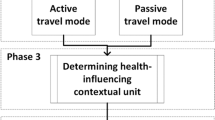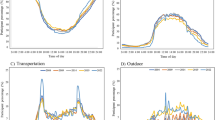Abstract
This study provides descriptive statistical data on daily time spent in three locations of exposure assessment interest for two panel studies of health-compromised elderly individuals >65-year-old having multiple days of human activity data. The panel studies include individuals living in Los Angeles (CA) and Baltimore (MD) in various housing types. Three general locations are evaluated: outdoors, in vehicles, and total indoors. Of particular interest is providing information regarding the within- and between-individual variability in the time use data for the three locations. The data are analyzed using non-parametric statistics and alternative statistical models. Within and between variability are evaluated using intraclass correlation coefficients (ICCs); daily “lag-one” autocorrelation coefficients are also provided for the two samples. There were significant gender differences for selected seasonal and/or day-of-the-week metrics for: (1) outdoor time in Los Angeles, but not in Baltimore, and (2) in-vehicle time in both areas. Elderly women spent more time in these locations than similarly aged men. The ICC statistic indicates that most of the variability in the time spent in the three locations is due to intraindividual variability rather than to inter-individual variability. The results indicate that US Environmental Protection Agency should consider gender, day-of-the-week, and time-of-day data in its exposure modeling of daily activities undertaken by the health-compromised elderly population.
This is a preview of subscription content, access via your institution
Access options
Subscribe to this journal
Receive 6 print issues and online access
$259.00 per year
only $43.17 per issue
Buy this article
- Purchase on Springer Link
- Instant access to full article PDF
Prices may be subject to local taxes which are calculated during checkout




Similar content being viewed by others
Abbreviations
- CHAD:
-
Consolidated Human Activity Database
- CHD:
-
coronary heart disease
- COPD:
-
chronic obstructive pulmonary disease
- EPA:
-
US Environmental Protection Agency
- ICC:
-
intraclass correlation coefficient
- KS:
-
Kolmogorov–Smirnov
- NHAPS:
-
National Human Activity Pattern Survey
References
Federal Interagency Form on Aging. Older Americans: Update 2006. Government Printing Office, Washington DC, 2006.
Geller A.M., and Zelnick H. Aging and the environment: a research framework. Environ Health Perspect 2005: 13: 1257–1262.
Glen G., Smith L., Isaacs K., McCurdy T., and Langstaff J. A new method of longitudinal diary assembly for human exposure modeling. J Expo Sci Environ Epidemiol 2008: 18: 299–311.
Graham S.E., and McCurdy T. Developing meaningful cohorts for human exposure models. J Expo Sci Environ Epidemiol 2004: 14: 23–43.
Hruschka D.J., Kohrt B.A., and Worthman C.M. Estimating between and within-individual variation in cortisol levels using multilevel models. Psychoneuroendocrinology 2005: 30: 698–714.
Isaacs K., Errickson A., Forbes S., Glen G., McCurdy L., McCurdy T., et al. Statistical properties of longitudinal time-activity data for use in human exposuremodels. Paper presented at the Annual Meeting of the International Society of Exposure Analysis; Durham NC 2007.
Kao T.C., Sparling Y., and Rochon J. Mixed-effect models to assess consistency and reliability across multiple evaluations. J Biopharm Stat 2003: 3: 539–548.
Krantz-Kent R., and Stewart J. How do older Americans spend their time? Monthly Labor Rev 2007: 130: 8–26.
Lawton M.P., Moss M., and Fulcomer M. Objective and subjective uses of time by older people. Int J Aging Human Develop 1986: 24: 171–188.
Leech J.A., and Smith-Doiron M. Exposure time and place: do COPD patients differ from the general population? J Expo Sci Environ Epidemiol 2006: 16: 238–241.
Leech J.A., Wilby K., McMullen E., and Laporte K. The Canadian human activity pattern survey: report of methods and population surveyed. Chron Dis Canada 1996: 17: 118–123.
Linn W.S., Gong Jr H., Clark K.W., and Anderson K.R. Day-to-day particulate exposures and health changes in Los Angeles area residents with severe lung disease. J Air Waste Manage Assoc 1999: 49: PM108–PM115.
Liu L.-J.S., Box M., Kalman D., Kaufman J., Koenig J., Larson T., et al. Exposure assessment of particulate matter for susceptible populations in Seattle. Environ Health Perspect 2003: 111: 909–918.
McCurdy T., Glen G., Smith L., and Lakkadi Y. The National exposure research laboratory's consolidated human activity database. J Expo Anal Environ Epidemiol 2000: 10: 566–578.
McCurdy T., and Graham S. Using human activity data in exposure models: analysis of discriminating factors. J Expo Anal Environ Epidemiol 2003: 13: 294–317.
McGraw K.O., and Wong S.P. Forming inferences about some intraclass correlation coefficients. Psychol Methods 1996: 1: 30–46.
Moss M.S., and Lawton M.P. Time budgets of older people: a window on four lifestyles. J Gerontol 1982: 17: 115–122.
National Center for Environmental Assessment. Exposure Factors Handbook. Vol. 3. U.S. Environmental Protection Agency, Washington DC, 1997 (EPA/600/P-95/002Fc).
Quackenboss J.J., Spengler J.D., Kanarek M.S., Letz R., and Duffy C.P. Personal exposure to nitrogen dioxide: relationship to indoor/outdoor air quality and activity patterns. Environ Sci Technol 1986: 20: 775–783.
SAS Institute. SAS/STAT User's Guide, Version 9.2 Edition SAS Institute Inc, Cary, NC, 2006.
Stewart A.L., Mills K.M., King A.C., Haskell W.L., Gillis D., and Ritter P.L. CHAMPS physical activity questionnaire for older adults: outcomes for interventions. Med Sci Sports Exercise 2001: 33: 1126–1141.
Tsang A.M., and Klepeis N.E. Descriptive Statistics Tables from a Detailed Analysis of the National Human Activity Pattern Survey (NHAPS) Data. U.S. Environmental Protection Agency (EPA/600/R-96/148), Las Vegas, 1996.
Verbrugge L.M., Gruber-Baldini A.L., and Fozard J.L. Age differences and age changes in activities: Baltimore Longitudinal Study of Aging. J Gerontol B: Psychol Sci Soc Sci 1996: 51B: S30–S41.
Verghese J., Lipton R.B., Katz M.J., Hall C.B., Derby C.A., et al. Leisure activities and the risk of dementia in the elderly. N Engl J Med 2003: 348: 2508–2516.
Williams R., Creason J., Zweidinger R., Watts R., Sheldon L., and Shy C. Indoor, outdoor, and personal exposure monitoring of particulate air pollution: the Baltimore elderly epidemiology-exposure pilot study. Atmos Environ 2000a: 34: 4193–4204.
Williams R., Suggs J., Creason J., Rodes C., Lawless P., Kwok R., et al. The 1988 Baltimore particulate matter epidemiology-exposure study: part 2-personal exposure associated with an elderly study population. J Expo Anal Environ Epidemiol 2000b: 10: 533–543.
Williams R., Suggs J., Zweidinger R., Evans G., Creason J., Kwok R., et al. The 1988 Baltimore particulate matter epidemiology-exposure study: part 1comparison of ambient, residential outdoor, indoor and apartment particulate matter monitoring. J Expo Anal Environ Epidemiol 2000c: 10: 518–532.
Winer BJ Statistical Principles in Experimental Design. 2nd edn. McGraw-Hill Book Co., New York, 1971.
Wolfinger R., and Chang M. Comparing the SAS GLM and MIXED Procedures for Repeated Measures. Proceedings of the Twentieth Annual SAS Users Group Conference SAS Institute, Cary NC, 1995.
Xue J., McCurdy T., Spengler J., and Özkaynak H. Understanding variability in time spent in selected locations for 7–12-year old children. J Expo Anal Environ Epidemiol 2004: 4: 222–233.
Zartarian V., Bahadori T., and McKone T. Adoption of an official ISEA glossary. J Expo Anal Environ Epidemiol 2005: 15: 1–5.
Acknowledgements
This research was supported by a grant to Dr. Frazier through the NAFEO (National Association for Equal Opportunity in Higher Education) Program funded by the US. Environmental Protection Agency's Washington D.C. Office of Research and Development (ORD). Troy Rutkofske of ORD's Integrated Services Staff and Rachel Cooke of NAFEO expedited the grant, and we thank them for their assistance. We also greatly appreciate the assistance of Dr. Graham Glen and Dr. Luther Smith of Alion Scientific in Durham NC for the Baltimore data from CHAD. The research reported by Linn et al. (1999) was supported by the Electrical Power Research Institute (grant no. WO-3215). This paper has been subjected to Agency review and approved for publication. Mention of trade names, commercial products, and organizations does not constitute endorsement or recommendation for use. We thank the Journal's two peer-reviewers for their thorough reading of the paper; we made many changes in the paper based on their comments and suggestions.
Author information
Authors and Affiliations
Corresponding author
Rights and permissions
About this article
Cite this article
Frazier, E., McCurdy, T., Williams, R. et al. Intra- and inter-individual variability in location data for two U.S. health-compromised elderly cohorts. J Expo Sci Environ Epidemiol 19, 580–592 (2009). https://doi.org/10.1038/jes.2008.47
Received:
Accepted:
Published:
Issue Date:
DOI: https://doi.org/10.1038/jes.2008.47
Keywords
This article is cited by
-
Statistical properties of longitudinal time-activity data for use in human exposure modeling
Journal of Exposure Science & Environmental Epidemiology (2013)
-
Longitudinal variability of time-location/activity patterns of population at different ages: a longitudinal study in California
Environmental Health (2011)



